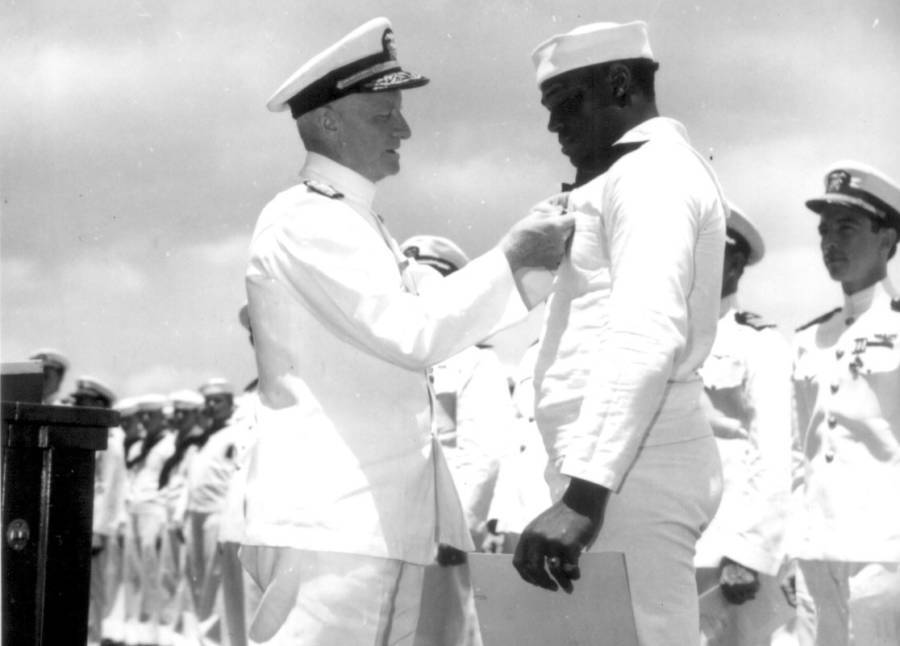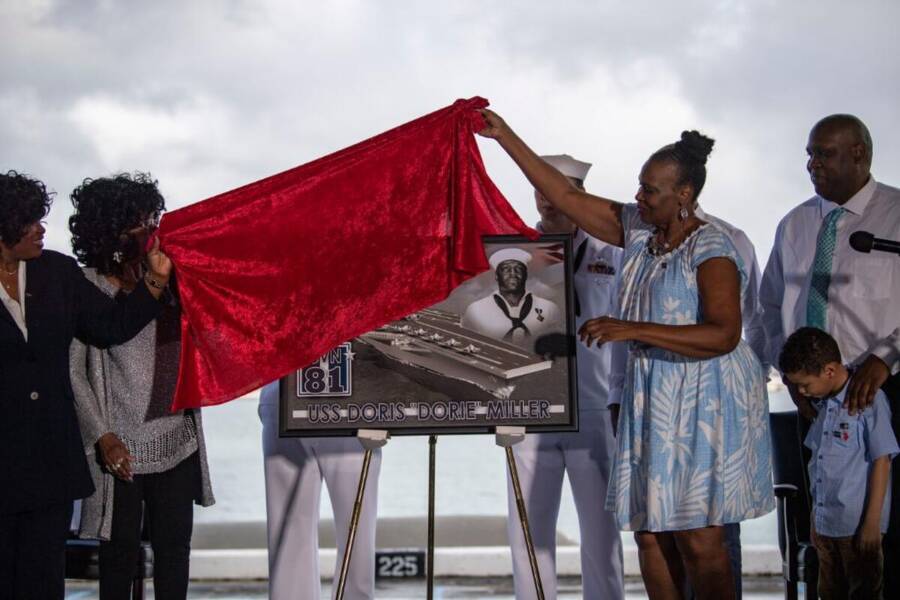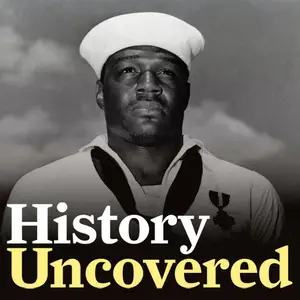Doris Miller: The Overlooked Sailor Who Became A Pearl Harbor Hero

U.S. Navy/Wikimedia CommonsAdm. Chester Nimitz awarding Doris Miller the Navy Cross on board the USS Enterprise.
Doris Miller’s quick actions and sharp skills helped U.S. troops fight off the attack from Japanese forces at Pearl Harbor — despite the fact that Miller had been relegated a position as a ship’s cook.
Doris Miller, better known as “Dorie” to his shipmates, was born on Oct. 12, 1919, in Waco, Texas, to Henrietta and Conery Miller.
Eager to serve his country, this remarkable Black hero enlisted in the U.S. Navy straight out of high school in 1939. But his early military career was not what he had expected.
Miller was incredibly athletic. A former high school quarterback, he had a stocky frame, stood at six-foot-three, and weighed more than 200 pounds. Despite his potential as a soldier, he was placed in a service position in the kitchen due to the racism within the military.
Like most Black army recruits at the time, Doris Miller was placed in a non-combat position as a cook on the Navy’s battleships. He was stationed aboard a number of ships before he finally landed on the USS West Virginia.
After brief training at gunnery school on board the USS Nevada, Miller returned to his station on the USS West Virginia in early August of 1940. His ship eventually made it to Pearl Harbor, Hawaii, as part of the Pacific Fleet.
On December 7, 1941, Doris Miller found himself in the thick of battle during the attack on Pearl Harbor by Japanese troops. Miller headed up deck after the first attacks and began carrying the wounded away to safety.
He then returned to the deck with two other crewmates and loaded two 50-caliber Browning anti-aircraft machine guns. Despite having no training to handle these guns, Miller readily operated the second machine gun.

Mass Communication 2nd Class Justin R. Pacheco/U.S. Navy
Miller’s family unveils a plaque commemorating the aircraft carrier named in his honor at Pearl Harbor on Jan. 20, 2020.
“It wasn’t hard. I just pulled the trigger and she worked fine,” Miller recalled after the attack. “I had watched the others with these guns. I guess I fired her for about fifteen minutes. I think I got one of those Jap planes. They were diving pretty close to us.”
Although there is some dispute about whether any of his shots had taken down any of the airplanes, there’s no doubt the hail of gunfire orchestrated by Miller and his crewmates helped prevent a far worse outcome at Pearl Harbor.

Unfortunately, the USS West Virginia ultimately sunk to the bottom of the ocean with 130 men killed aboard the ship.
On Dec. 15, 1941, the Navy released its commendations for actions at Pearl Harbor including for one “unnamed Negro.” At the behest of the NAACP, the Navy formally recognized the Black soldier as Doris Miller a year later.
Sadly, Doris Miller died in action on Nov. 24, 1943, on board the USS Liscome Bay in the Pacific Ocean after the ship was attacked by a torpedo from the Japanese Navy.
He was later awarded the Navy Cross, the second-highest award for military service in the Navy, establishing Miller as the first Black man honored with the award. The recognition prompted the Navy to take steps to allow Black recruits to serve in combat roles.
On Martin Luther King Day in 2020 — nearly eight decades since his act of courage at Pearl Harbor — Doris Miller received another high honor more befitting his service: an aircraft carrier named in his honor. With that, Miller became the first Black man in U.S. history to receive such a tribute.
The USS Doris Miller is officially scheduled to set sail in 2028.





